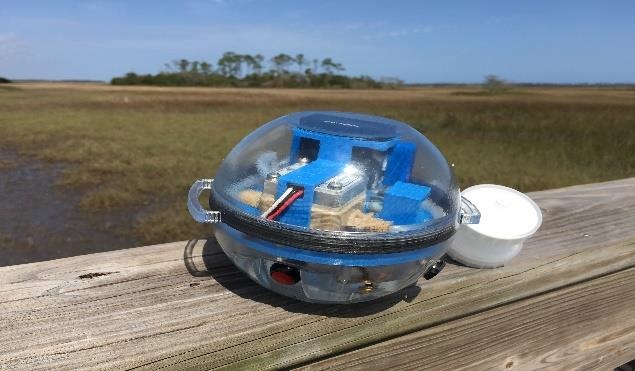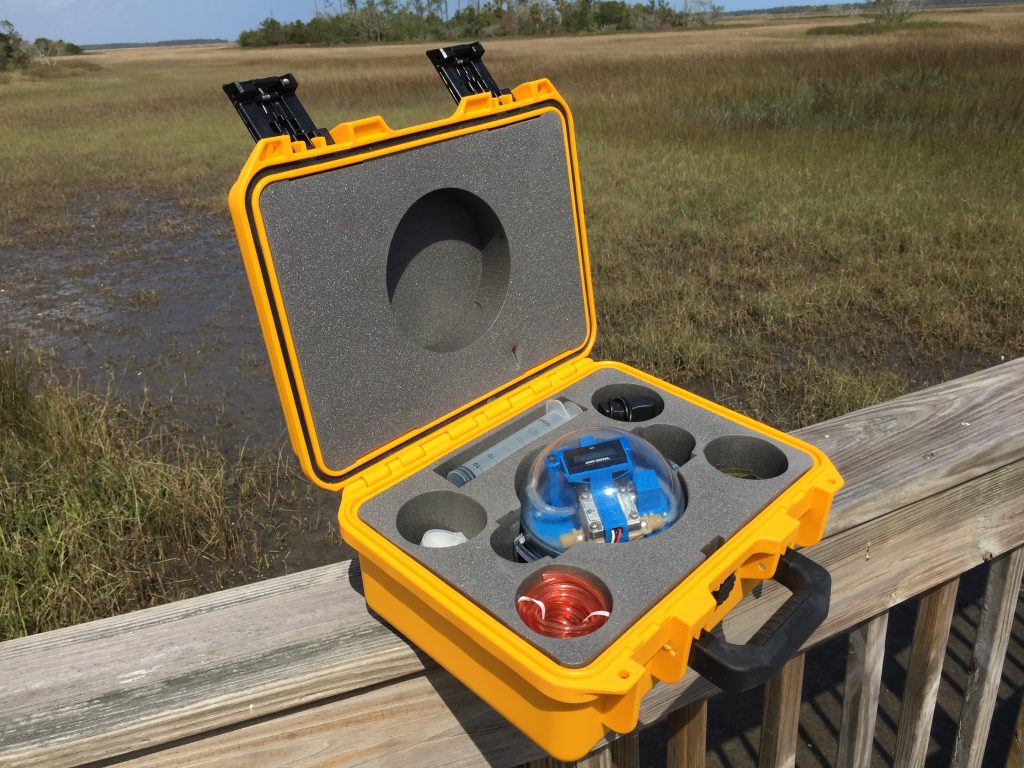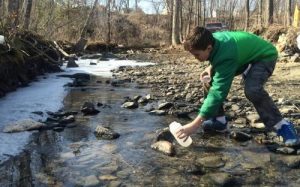CLAM vs Traditional Sampling
There are several water sampling methods currently being used within the environmental industry, including grab sampling, automatic samplers and passive sampling, but they all have various issues. Find out how the Continuous Low-Level Aquatic Monitoring (CLAM) method compares to these traditional sampling techniques.
How Does the CLAM Compare?
RESULTS
| Trace organics water monitoring, both total and dissolved | Many types of contaminates can be monitored |
| Provides a 1 to 36 hr extraction event, sequestering episodic and chronic pollutants | Samples a 1 second “snapshot” in time, thus incapable of monitoring episodic events |
| Multiple methods obtained from one solvent extract of a single deployment | Typically not enough sample volume for multiple methods |
| Up to 100 liters can be sampled, thus providing very low detection capabilities | Typically provides a 1 liter sample, thus yielding that level of detection |
| Pre-extracted disk is simply solvent eluted at your lab | Sample has to be solvent extracted in the lab before elution |
CONVENIENCE / MOBILITY / SECURITY
| Disk(s) are all that need to be sent to the lab | Bottles and coolers need to be sent to the lab, which adds to overall weight and increases shipping costs |
| CLAM complete kit and CLAM disk(s) are taken to the field | Cooler and water bottles taken to field |
| Disks are conditioned with a solvent rinse before field deployment | Coolers and water sample bottles prepared and picked up prior to fieldwork |
| Easy and cost-efficient to ship: the disk represents up to 100 liters of water but weighs only a few ounces | Difficult and expensive to ship: 100 liters of water can easily weigh more than 200 lbs. |
| Powered rechargeable lithium ion batteries | No power source is needed |
| A minimum of two visits are required for a complete deployment and retrieval | Only requires one site visit |
| Must be mounted and in stealth environments to protect from theft | Simple 1 liter collection of water |
| Water extraction is completed in the field | Water extraction is completed in the lab |
HOLDING TIMES
| Extracted sample can be frozen for 2 months up to 1 year with no degradation on sorbed analytes | Seven day holding time to perform extraction; exceeding this renders the sample unusable |
RESULTS
| Trace organics water monitoring, both total and dissolved | Any water sample testing can be conducted |
| Pre-extracted disk is simply solvent eluted at your lab | Sample has to be solvent extracted in the lab before elution |
| Water is extracted through the SPE disk first, thus no analytes are lost on surfaces | Hydrophilic compounds results have a low bias because the tubing and containers adsorb some analytes |
| Provides a 1 to 36 hr extraction event, sequestering episodic and chronic pollutants | Intermittent sampling provides many snapshots averaged for concentrations |
| Aliquots can be divided for multiple analyses | Multiple bottles provide opportunities for multiple analyses |
| Up to 100 liters can be sampled, thus providing very low detection capabilities | Typically samples less than 3 liters in a given bottle, thus yielding that level of detection |
| Multiple methods obtained from one solvent extract of a single deployment | Typically not enough sample volume for multiple methods |
CONVENIENCE / MOBILITY / SECURITY
| Disk(s) are all that need to be sent to the lab | Bottles and coolers need to be sent to the lab, which adds to overall weight and increases shipping costs |
| Easy and cost-efficient to ship: the disk represents up to 100 liters of water but weighs only a few ounces | Difficult and expensive to ship: 100 liters of water can easily weigh more than 200 lbs. |
| Small and easy to carry and deploy | Heavy and bulky, in excess of 50 lbs. or more |
| Must be mounted and in stealth environments to protect from theft | Must be hard mounted with security in mind |
| Powered rechargeable lithium ion batteries | Must plug into a full power source |
| Water extraction is completed in the field | Water extraction is completed in the lab |
| A minimum of two visits are required for a complete deployment and retrieval | A minimum of two visits are required |
HOLDING TIMES
| Extracted sample can be frozen for 2 months up to 1 year with no degradation on sorbed analytes | Seven day holding time to perform extraction; exceeding this renders the sample unusable |
RESULTS
| Up to 100 liters can be sampled, thus providing very low detection capabilities | One month partitioning event provides high analyte sequestered concentrations |
| Can provide quantitative compliance testing, for both total and dissolved fractions | Provides a qualitative estimated value only |
| Provides a 1 to 36 hr extraction event, sequestering episodic and chronic pollutants | Requires a one-month integrative partitioning event to establish equilibrium |
| High volume extraction during single deployment provides ultra low detection capabilities | Sequestering equilibrium event provides low estimate of detection |
| Multiple methods obtained from one solvent extract of a single deployment | Multiple methods obtained from extract solvent aliquoting |
| Pre-extracted disk is simply solvent eluted at your lab | Specialty labs required to separate triolene fat from trace organic pollutants |
| Trace organics water monitoring, both total and dissolved | Trace organics water monitoring, dissolved only |
CONVENIENCE / MOBILITY / SECURITY
| Powered rechargeable lithium ion batteries | No power source is required |
| A minimum of two visits are required for a complete deployment and retrieval | A minimum of two visits are required |
| Disks are conditioned with a solvent rinse before field deployment | Days of preparation is required of solvent extraction to “proof” before field deployment can occur |
| Easy and cost-efficient to ship: the disk represents up to 100 liters of water but weighs only a few ounces | Easy and cost-effective to ship, weighing only a few pounds |
| Disk(s) are all that need to be sent to the lab | Partitioned fat tube needs to be sent to the lab |
| CLAM complete kit and CLAM disks are taken to field | Similar equipment must be taken to the field |
| Must be mounted and in stealth environments to protect from theft | Stainless steel apparatus must also be mounted and in stealth environments |
| Small and easy to carry and deploy | Small and easy to carry and deploy |
HOLDING TIMES
| Extracted sample can be frozen for 2 months up to 1 year with no degradation on sorbed analytes | Holding time duration has not been studied |
CLAM Sampling – Active Field Extractions
The CLAM (Continuous Low-Level Aquatic Monitoring) has redefined the entire water sampling procedure for labs and researchers alike. As an in-situ submersible field extraction unit that has captured the continuous sampler ideal of being small, stealth, and able to field sample for extended periods of time continuously in a quantitative manner, it mimics a real clam or indicator organism. It provides active sampling by filtering the water at a low flow rate, while capturing total and dissolved organics within its SPE cartridge. It is immune to effects of temperature, flow and bio-fouling, and provides ultra-low quantitative detection capabilities.
Grab Sampling
Environmental water testing presently uses grab sampling, which typically yields a one-liter sample the water testing laboratory will analyze, which represents a snapshot in time. This sample doesn’t reflect the dynamic changes in a flowing or changing body of water, and can miss episodic and illicit events. The one-liter water sample does not allow the labs to achieve low level water analysis for sub-lethal levels of trace organics, pharmaceuticals, or other emerging target analytes.
Passive Sampling
Relatively simple and inexpensive, passive sampling was developed as an alternative to both grab sampling and automatic water sampling, and provide a time-integrative partitioning event and ultra-low qualitative detection. This type of water monitoring equipment can be deployed for weeks to months at a time, utilizing equilibrium partitioning to slowly sequester and concentrate pollutants into fat or resin media over time. The passive samplers extract the target pollutants from the water and leave it behind. The water analysis report yields only qualitative results that are influenced by temperature, water flow, location, and bio-fouling.
Automatic Sampling
Automatic samplers were developed to produce a type of water sample that represents more than a few seconds of the changing dynamics of a river, urban runoff, stream or watershed. Bulky, heavy and expensive, these devices draw water samples on an intermittent basis for days at a time, utilizing pumps and tubing and usually a large collection vessel, all of which will adsorb target hydrophilic pollutants onto their surface, severely affecting the true values of the original water samples in the water analysis report. Their size and weight prevent their use in remote areas, and usually require tamper proof structures to house them. They do not provide low level analysis capabilities as they only provide a one liter subset sample for the water testing lab.
Unique Design Features of the CLAM

- Allows water to pass through SPE cartridge first with its submersible design.
- Special extraction disks are field hardened, and remain outside the unit for easy replacement.
- Low flow rates of 1-75 ml/min helps prevent premature plugging from floatables, as compared to high suction devices.
- Disks can contain variety of media to integrate non-polar and polar trace organics.
- Ability to integrate pollutants in 100 liters of water quantitatively, allowing ultra-low detection levels.
- Will run unattended submerged for 48 hours on rechargeable batteries. Battery and disk change can support longer deployments.










